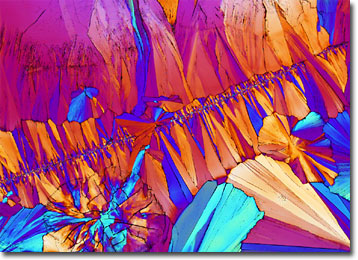Polarized Light Microscopy Digital Image Gallery
Ephedrine
Ephedrine is a stimulant originally derived from Asiatic shrubs of the genus Ephedra, though it has been synthesized in laboratory settings since the 1920s. Also known as ma huang, the Chinese have utilized the substance for medicinal purposes for several thousand years.

In the United States, ephedrine is sold under a variety of trade names, usually as a component of over-the-counter drugs intended to treat congestion, coughing, wheezing, and related symptoms of asthma, bronchitis, and lung disease. The alkaloid achieves its effect on the body primarily through the discharge of excitatory chemicals called catecholamines. The catecholamines, which act upon cellular receptors, effectively stimulate lipolysis, dilate the bronchioles, accelerate the heart rate, increase alertness, and often diminish one’s appetite. These effects generally diminish after a period of several hours.
Despite its long history of usage, ephedrine has recently been the subject of a significant amount of controversy. Part of this controversy has stemmed form the increasing use of the substance over the past few decades to produce methamphetamine, which is often utilized as a street drug. However, just as questionable has been the relentless marketing of the alkaloid as a diet supplement, despite the fact ephedrine may have potentially serious side effects, especially when utilized in conjunction with other synergistic stimulants. Some of the adverse reactions that have been experienced by consumers of ephedrine-based products include nervousness, hypertension, heart rate irregularities, tremors, respiratory depression, strokes, and heart attacks.
